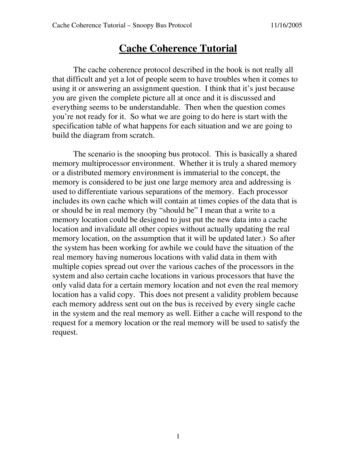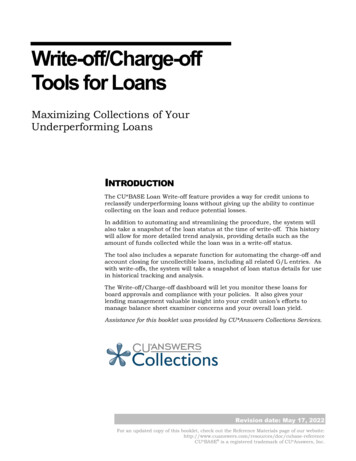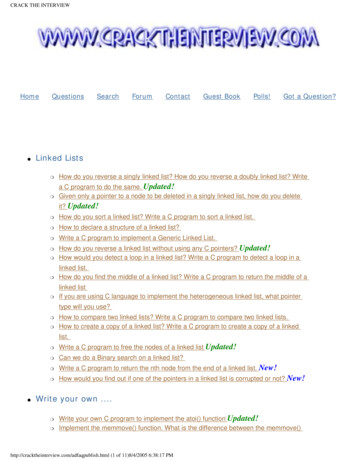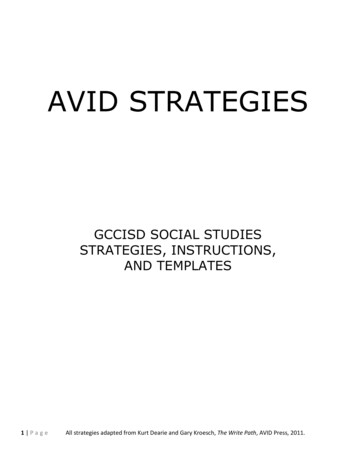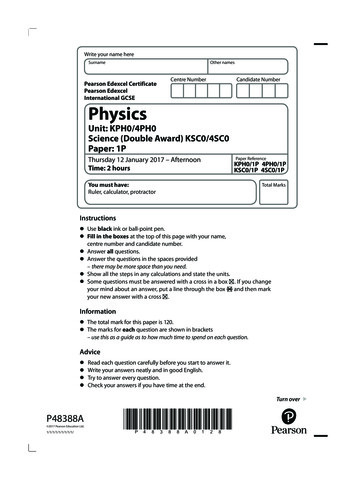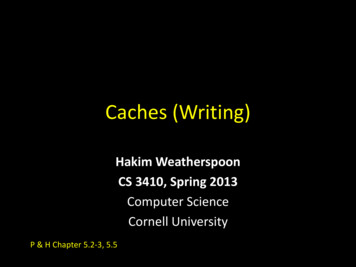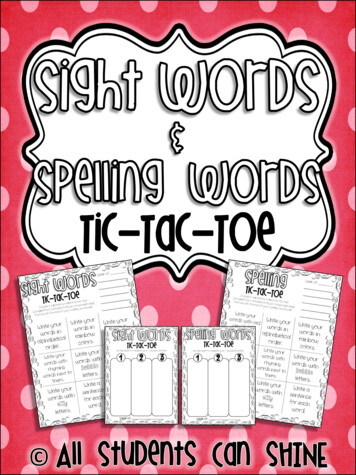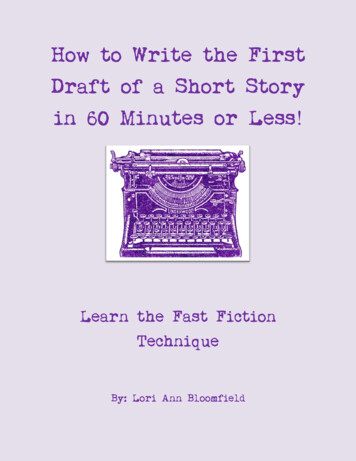
Transcription
How to Write the FirstDraft of a Short Storyin 60 Minutes or Less!Learn the Fast FictionTechniqueBy: Lori Ann Bloomfield
This report is free. Read it, use it and share it withthe world under the terms of Creative CommonsAttribution 3.0 License. 2013 Lori Ann Bloomfieldwww.loriannbloomfield.com2
You don't need to know the story when you startwriting. You write to discover the story. Just begin.IntroductionI used to fill notebooks with fragments of ideas for stories. I’d jot downone line summaries of plots, bits of dialogue, descriptions of characters, orscenes. Then time would pass and when I eventually reread these randomscrawls I couldn’t remember why I’d been so excited about the idea in the firstplace.The problem was I was letting too much time go by and that first sparkof inspiration was getting extinguished. But I often didn’t have enough time towrite a full draft. Clearly, I had to do something though. My notebooks werestarting to look like graveyards for story ideas.And so I developed the Fast Fiction technique. It was a way for me totake that initial spark of inspiration and develop it into a rough draft of a shortstory in an hour or less!Before we get started I want to explain what I mean by a rough draftand how it differs from a first draft. Think of it this way: a rough draft is like awww.loriannbloomfield.com3
sketch, whereas a first draft is like a drawing. A rough draft doesn’t haveevery word of the short story in it, like a first draft does. In a rough draft youdiscover who is in your story, where it takes place and some (but probably notall) of what happens. A rough draft is your starting point. It is where you firstcommit your story to the page and begin to develop it.When I started using the Fast Fiction technique I began finishing farmore short stories. I’ve also found this technique useful for writing essays,blog posts and articles. It has even helped me outline novels. I encourage youto experiment with it and make it your own.www.loriannbloomfield.com4
All your potential awaits you on the white page.Donot hesitate – write.How This WorksIn the next section I am going to give you a series of writing exercises todo. Some require you to jot down only a few words, some require a sentence,and for others you’ll write several paragraphs. I often create my rough draftsusing a timer, so I’ve provided suggested time limits. Try to do each exerciseas quickly as possible without thinking too much. You’re trying to bypassyour inner critic and directly access your creativity. Moving fast allows you todo that. Your Muse like speed. Don’t worry about spelling or punctuation.We’re only concerned with generating ideas and getting words down at thispoint.www.loriannbloomfield.com5
Write first drafts quickly.The Muse loves speed andfavours the fearless.I prefer to write in longhand. There is something about my handmoving across the page that helps my creativity flow, but if you prefer writingon a computer, please do so. What matters most is that you are writing.And one last thing: there is no wrong way to do this.www.loriannbloomfield.com6
When your fingers can't keep up with your words, youknow you're on the right track.Rough Draft In Zero to Sixty1. Describe your story in one sentence. (1 min)2. Make of list of 5-10 words that describe the mood of yourstory. (2 min)3. Describe the main character.Who is telling this story orwho is this story about? (10 min)www.loriannbloomfield.com7
4. Describe the setting of the story.take place? Indoors?Outdoors?Where does the storyOn this planet? Try to useall your senses when you describe it, not just your sight.Your story will probably have more than one setting, butstick to describing the main one, or the most important onefor now. (10 min)5. Every story needs a conflict.What is the problem thatneeds to be solved in your story?6. Describe a second character.(5 min)(5 min)7. Write a scene in dialogue between your main character andthis second character. (10 min)www.loriannbloomfield.com8
8. What happens in this story? Write the plot in point form.Don’t worry if you don’t know the ending yet.(10 min)9. Write the first paragraph. (5 min)10. Make a list of 3-5 possible titles for the story. (2 min)Congratulations. You did it! You have a rough draft! But what exactlydo you have?www.loriannbloomfield.com9
Writing is the best writing teacher.What You’ve GotThe most important thing you’ve got is words on paper (or saved onyour computer). This is way better than just having a vague idea floatingaround in your head or a languishing fragment in a notebook. You’ve justtaken the most important step in actually writing a short story.Broken down, you now know a bit about your story. You know who themain character is, and who, at least, one of the other characters is. You’ve gota conflict, or you know what is at stake. This is a seriously big step, manystories sputter out at this crucial point. Without a conflict there is no drama todevelop. You also know the general arc of the story.(Hint: Don’t worry if you are not clear on all these things at this stage.You’ve made a start which is the most important thing. My stories often start offvague, like I am trying to remember a dream and slowly they come into focuswith each consecutive draft. Also don’t worry if things change as you keepwww.loriannbloomfield.com10
working on your story. That’s normal, too.)At this point you’ve got a:A Road map of the story- #10 (Title)- #1 (One Sentence Summary of Story)- #2 (Mood of Story)- #5 (Conflict)- #8 (Plot Outline)You’ve also got an:An Outline of the story- #9 (First Paragraph)- #3 (Description of Protagonist)- #4 (Setting)- #6 (Second Character)- #7 (Scene in Dialogue)www.loriannbloomfield.com11
Write with the curiosity of an explorer, the courage of awarrior and the compassion of an angel.What Happens Next?After writing your rough draft you can either start on a first draft rightaway or wait a few days. Sometimes creating a rough draft is like planting aseed. You may need to give your story time to sprout. Other times, writing arough draft is like building a fire and you want to touch a match to it rightaway to get it burning.www.loriannbloomfield.com12
Forget what everyone else will think.Write toplease your 95-year-old self.Whichever approach you take I hope you continue to work on yourstory, through draft after draft, until it is finished because you are the onlyperson who can write it. You are the only person who can breathe life intothese characters and situations.And I want to read your story.Happy Writing!Loriwww.loriannbloomfield.com13
For more inspiration, or to sign up for my newsletter, visit:www.loriannbloomfield.comLori Ann Bloomfield is author of the novel, “The LastRiver Child” (Second Story Press).She has published dozens ofshort stories, poems and essays in literary journals in Canadaand the USA. When not at her desk writing, she teacheswriting, coaches writers and practices yoga.www.loriannbloomfield.com14
1. Describe your story in one sentence. (1 min) 2. Make of list of 5-10 words that describe the mood of your story. (2 min) 3. Describe the main character. Who is telling this story or who is this story about? (10 min)


